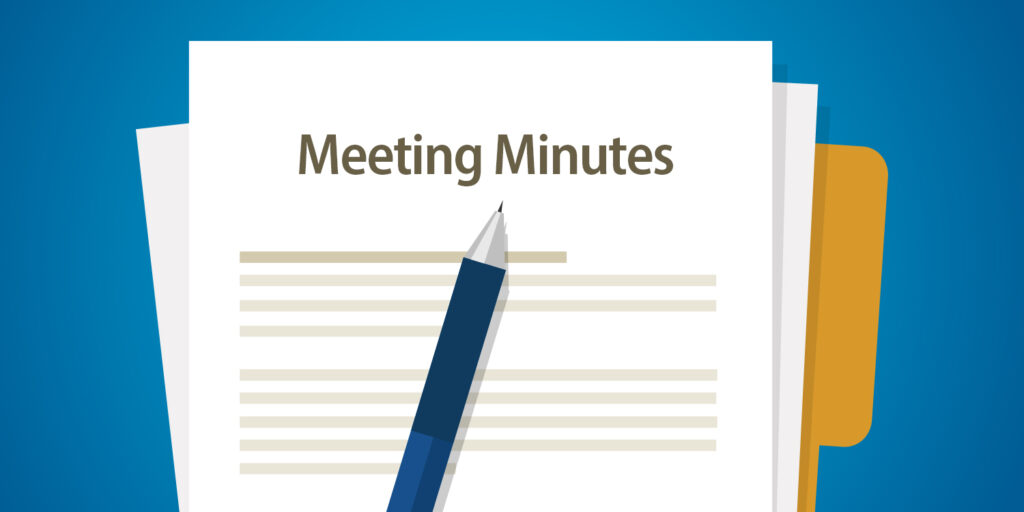By law, UK limited companies must keep meeting minutes of all board meetings and general meetings. These minutes serve as an official written record of proceedings, including key matters of discussion and formal decisions.
Whilst this sounds like a simple enough task, minute taking can be complex and challenging, particularly if you’re also an active participant in the meeting. This guide explains how to keep effective meeting minutes for your small business and avoid the most common pitfalls.
What are meeting minutes?
Meeting minutes are formal notes taken during a meeting. They document key details and provide a concise written summary of discussions, proposals, votes, and actions. Minutes are not, as the name suggests, a minute-by-minute record of events.
The purpose of keeping meeting minutes is to create an official record of proceedings that can be used as a source of information for future reference. Aside from being a legal requirement for limited companies, minutes promote transparency, provide a recap and clarification for participants, and inform those who were unable to attend.
Serving as written proof of events, minutes are often essential for demonstrating corporate compliance, resolving internal disagreements, or using as a defence against legal action. They also help to measure a company’s progress, inform future business decisions, and ensure all parties are adhering to their assigned responsibilities.
What to include in minutes of company meetings
Where applicable, minutes of company meetings should include the following information:
- Type of meeting – For example, first board meeting of the directors, regular board meeting, annual general meeting of the members, emergency board or general meeting.
- Full company name – This may sound obvious, but it’s surprising how often people forget to include this important detail. Without the company name, there is no proof that the minutes refer to a meeting within your particular organisation.
- Date, time, and location – Minutes should indicate the date of the meeting (DD/MM/YYYY), the start time, the time at which the meeting adjourned, and the location where the meeting took place.
- Names of all attendees (including their roles/job titles), those who were absent, and any shareholder proxies or alternate directors in attendance.
- Important announcements, including amendments or corrections made to previous meeting minutes.
- Proposed resolutions – These are formal proposals put forward for discussion and debate, with the intention of being put to a vote.
- Outcome of proposed resolutions – Decisions taken (i.e. ‘passing a resolution’) or motions rejected at the meeting, including the number of votes cast for and against, and by whom. These types of formal decisions are known as company resolutions.
- Next steps such as plans, timescales, and deadlines for agreed actions, and who is responsible for carrying them out.
- Summary of all key points discussed, including any new business, and who said what.
- Additional information – This can include agenda items held over until the next meeting or a later date, or a description of any documents distributed during the meeting. A copy of any additional materials should be attached to the minutes for reference.
Meeting minutes should always be professional and never include personal comments, observations, or opinions of the minute taker.
Top 10 tips for effective meeting minutes
The key to keeping meeting minutes is understanding what to include and what to leave out, which is easier said than done. To help you to keep effective minutes for your business, follow these top 10 tips:
1. Choose a skilled minute taker
If possible, assign the task of keeping meeting minutes to an experienced, impartial individual who is not actively participating in the meeting. By doing so, the minute taker can focus their full attention on accurately recording the discussions, decisions, and actions that take place during the meeting.
2. Refer to the agenda before the meeting
Familiarise yourself with the meeting agenda ahead of time, and use it to create an outline for the meeting minutes. This will help you to understand the purpose and context of the meeting, review additional materials provided, get to grips with the proposed topics of discussion and unfamiliar terminology, and clarify anything that you do not fully understand.
3. Arrive early
Arrive at the meeting location early. This will ensure that you have ample time to get set up and consult with the organiser about agenda changes or matters requiring clarification, including the timeline for returning or distributing the completed minutes.
Situate yourself in a position where you will be able to see all attendees, hear discussions clearly, and view any visuals (e.g. screens or presentation boards) with ease. Ensure you have access to a power source, if required. You may also find it useful to make a note of where all attendees are seated.
4. Avoid handwritten meeting minutes
Using a laptop is far more efficient than taking handwritten notes. However, if you struggle to keep up, consider recording the meeting as well. You can refer to this afterward to fill in gaps in your notes and confirm certain points.
Create typed meeting minutes for digital distribution and store the document electronically. You may also wish to keep a printed copy of the minutes for your company records.
5. Don’t write down every word that is said
You should not attempt to capture everything that is said and done at the meeting. Minutes are not a legal transcript or verbatim account. Rather, meeting minutes are a concise summary of key points of discussion and outcomes.
In many meetings, a lot of what is said is irrelevant to the minutes – introductions and small talk, non-work-related conversations, straying off-topic, opinions and debate. You should not record these extensive details.
Instead, summarise the salient points of the discussion under the appropriate agenda item, attributing each one to the relevant attendee.
Record any decisions that were made and how they were reached, noting disagreements and objections. Sum up any follow-on actions, including deadlines and who has been tasked with any such responsibilities.
6. Follow a logical structure
Meeting minutes should be structured and organised in a logical manner. So, rather than keeping a chronological record of events, it is best to summarise all related points, decisions, and actions in one section.
For example, if a particular topic is discussed numerous times throughout the meeting, record and sum up this subject matter under the relevant agenda item in the minutes. This is one of the reasons why it is beneficial to create a template based on the meeting agenda ahead of time.
7. Be consistent
Follow a consistent style and format for all meeting minutes of the company, including verb tenses (past tense is preferable) and document presentation.
You may wish to create a standard template that can be used and amended as appropriate, or take advantage of meeting minutes tools such as Google Docs, Evernote, or Magic Minutes.
Having a pre-prepared template based on the meeting agenda will make it much easier to record notes, decisions, and actions in the correct sections throughout the meeting.
8. Take an impartial approach
Remain objective in your notes by recording discussions and decisions without personal judgment or opinion. Stick only to the facts. Use language that is professional, clear, and unambiguous. Summarise and paraphrase without the omission of essential points, and avoid the use of adverbs and adjectives.
9. Clarify anything you do not hear or understand
Ask for clarification if you are unsure about any points of discussion, terminology, the outcome of proposals, or next steps. It can be tempting to avoid interjecting and simply let things slide, but doing so may affect the quality and accuracy of the meeting minutes. This could cause serious issues further down the line, so it’s important to be confident and assertive in the role.
10. Finalise the minutes as quickly as possible
Try to create the final copy of the meeting minutes as soon as possible after the meeting adjourns. It is much easier to do while everything is still fresh in your mind.
Once complete, the minutes should be approved by the chairperson prior to being shared with all relevant parties online.
Use the same file naming convention for all meeting minutes, and store a digital copy and hard copy in designated folders that are easy to locate.
Storing minutes of meetings
When keeping meeting minutes for a limited company, section 355 of the Companies Act 2006 states that “[the] records must be kept for at least ten years from the date of the resolution, meeting or decision (as appropriate).”
Whilst best practice dictates that important documentation should be stored electronically, it can be beneficial to keep a printed copy of meeting minutes at your registered office or business address as well. By doing so, you can quickly and easily refer to the minutes in whichever format works best for you at any given time.
Who is the best person to take minutes of meetings?
Anyone present at a meeting can be tasked with keeping meeting minutes. However, it is best to assign the role to someone who is skilled and experienced in such matters, for example, a personal assistant or secretary.
They require effective listening skills, great attention to detail, excellent command of the written language, a quick typing speed (shorthand skills are even better), and a good understanding of the business itself.
Ideally, the minute taker should not be an active participant in the meeting. The task requires their full attention, which is not possible if they are expected to be involved in discussions and decision making as well.
Often, the minute taker will also be responsible for setting up the meeting room, preparing and arranging equipment and any refreshments required, and liaising with the chairperson and attendees.
Not everyone has the necessary skills to keep effective meeting minutes, so it is important to choose wisely to ensure your company’s minutes are perfect every time.
Thanks for reading
If you have any questions about this post, or require help with any other aspect of running a limited company, please leave a comment below or get in touch with our company formation team.
Please note that the information provided in this article is for general informational purposes only and does not constitute legal, tax, or professional advice. While our aim is that the content is accurate and up to date, it should not be relied upon as a substitute for tailored advice from qualified professionals. We strongly recommend that you seek independent legal and tax advice specific to your circumstances before acting on any information contained in this article. We accept no responsibility or liability for any loss or damage that may result from your reliance on the information provided in this article. Use of the information contained in this article is entirely at your own risk.






Join The Discussion
Comments (6)
What process should be followed if some of the directors who were present at a directors’ meeting (of a small property management company) dispute that the minutes of said meeting constitute an accurate record of discussions because they do not include opinions expressed by individuals (themselves) and debate engaged in? Is it sufficient to record that a majority of directors present at the relevant meeting or subsequent meeting approved the Minutes?
Thank you for your kind comment.
Unfortunately as we are not regulated to provide legal advice, we are unable to provide advice on specific scenarios. We would recommend contacting a solicitor for further assistance.
Please accept our apologies for any inconvenience caused.
Kind regards,
The 1st Formations Team
What are the rules on ‘re voting’ on a resolution? (Property Management Company Ltd in UK)
The result of a vote to elect a director held at an AGM are being disputed and the chair wants to re ballot shareholders. I have read that only those shareholders who voted in person at the first vote (there were no proxy votes) can vote on it again. The chair also want to hold the ballot by email. Please advise
Thank you for your kind enquiry, Janet.
As a general rule, we are not aware of any specific rules regarding disputed results of a resolution of the shareholders. However, we would suggest in the first instance that you review your company’s articles of association for any provisions that might apply to your circumstances. For example, article 44 of the model articles of association provides for certain “errors and disputes” – this includes any objections regarding the qualification of a person to vote at a general meeting and that “every vote not disallowed at the meeting is valid”. It further states that “any such objection must be referred to the chairman of the meeting, whose decision is final”.
Finally, regarding your point that the chair wishes to hold the ballot by email – we would note that decisions of the shareholders of a company should be taken either at a general meeting or by way of written resolution. We would suggest that, for any resolutions circulated and passed electronically, care is taken to ensure the requirements of passing a written resolution are met. The rules surrounding shareholder written resolutions can be found in Part 13 Chapter 2 of the Companies Act 2006.
We trust this information is of use to you.
Kind regards,
The 1st Formations Team
Thanks! I will keep this in mind in my next meeting
We are glad you found this article of use, Scarlett.
Kind regards,
The 1st Formations Team